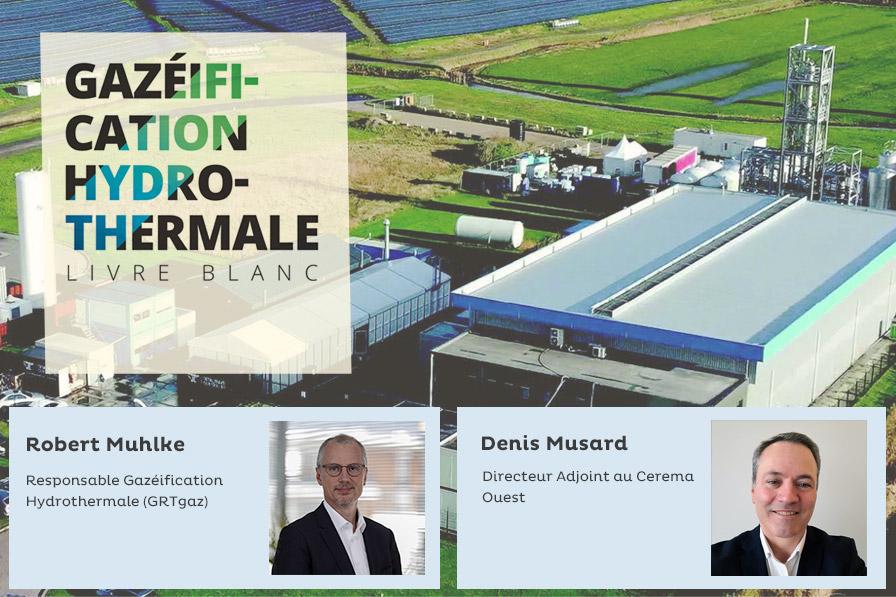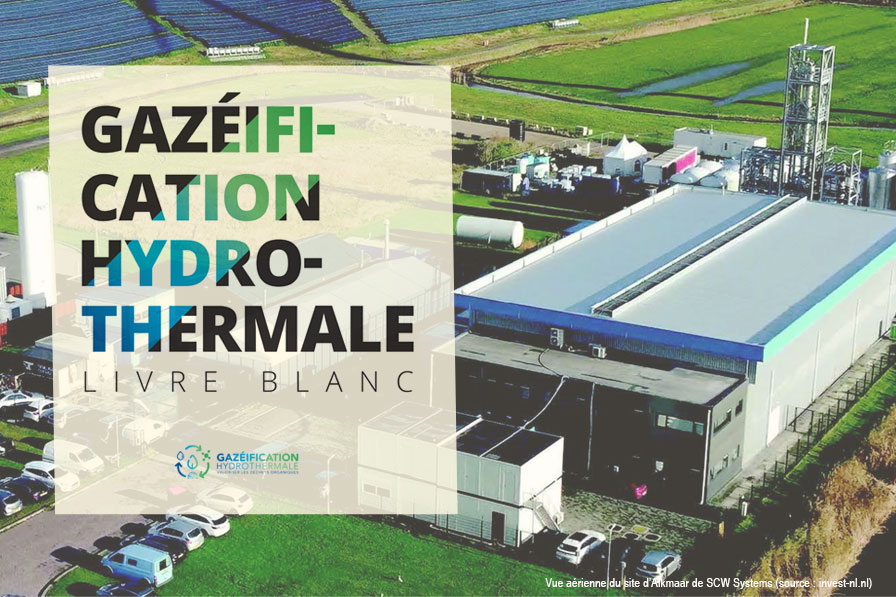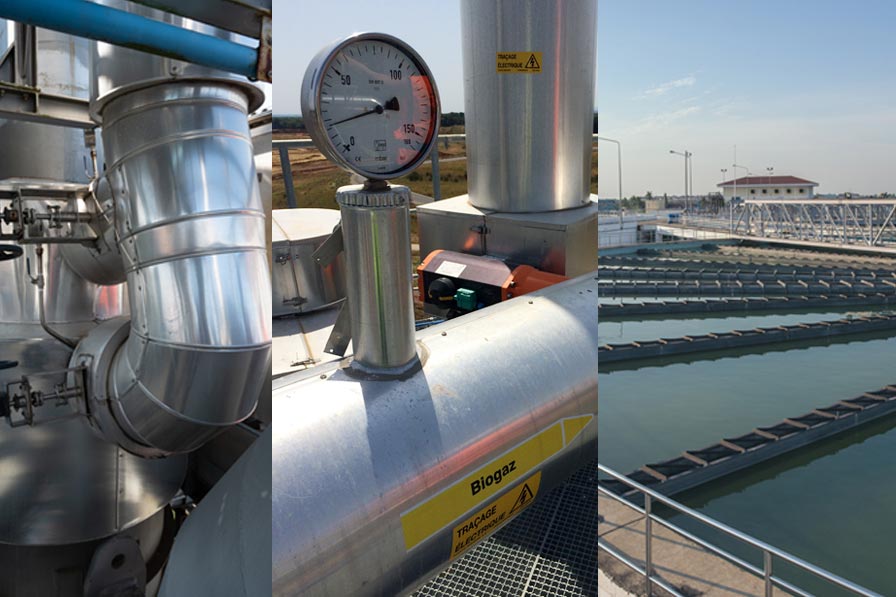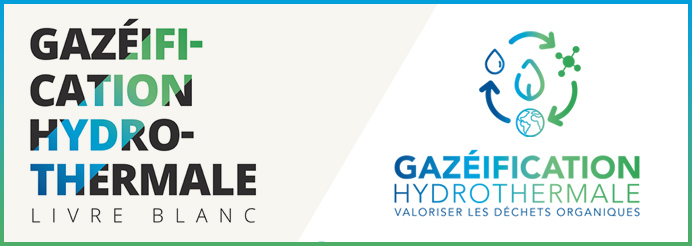All about Hydrothermal Gasification in a White Paper

An innovative technology enabling the production of renewable and low-carbon gas from wet organic waste, Hydrothermal Gasification deserved to have its chance at development. GRTgaz decided to set the wheels in motion from as early as 2021, establishing a Working Group (WG) made up of industrial players, local authorities, equipment manufacturers, associations and consultancies. The result was a White Paper, published at the start of the year to pave the way for the sector’s industrialisation. Robert Muhlke, Head of Hydrothermal Gasification at GRTgaz, and Denis Musard, Deputy Director at Cerema Ouest, tell us about it.
What prompted you to write this Paper?
Robert Muhlke: Initially, the aspiration was to introduce this technology to industrial players, local authorities, political decision-makers, institutions and all other stakeholders. The White Paper takes stock of the technology’s advantages and prospects in France and Europe. The regulatory framework on which the sector will be based remains to be defined. We address all the other aspects as well: the various sources of recoverable waste at the local level, how the process works, its added value compared to incineration, the value chain it entails, the business models, and the economic picture it represents on a large scale. It is a very complete work, which is intended to be shared with stakeholders and an informed public. The publication was announced at the Bio 360 trade fair in Nantes on 8 February, alongside several partners. Among them is the CEREMA, co-author of this work, and co-head for the regulatory and technical section.
Denis Musard: The idea was to reach out to territories with answers to their gas supply and waste recovery problems, as a public body dedicated to supporting their sustainable development. There was no precedent offering a state of the art of the sector: it became clear that a white paper was needed to provide a reference tool on the solutions proposed by Hydrothermal Gasification. We found this out ourselves when we identified the demonstrator project (now called GHAMa), which was one of the candidates selected to accompany the planned closure of the EDF coal-fired power plant in Cordemais, in the Loire-Atlantique department. We contributed to an argued feasibility study of the demonstrator. From our perspective, this technology is somewhat of a cornerstone that has been missing until now to create a circular economy for renewable and low-carbon gas, with an ecosystem approach: it supplements or provides an alternative to anaerobic digestion and pyrogasification (production of renewable and low-carbon gas from solid waste) and enables a complete recycling loop for organic waste by depolluting and recovering useful components such as nitrogen, minerals and water, which consumed or returned to the soil, with a good carbon balance. We felt like pioneers in its development, working alongside the employees at GRTgaz, where we found a spirit of creative cooperation, as well as local players, start-ups and innovation labs involved in the adventure. This stimulating alchemy enabled us to build a clear vision of what this sector will contribute in the future.
Precisely: how does the White Paper describe the sector’s future?
Robert Muhlke: Through the Paper, we also wanted to explain how this technology can support the gas market in France and Europe and contribute to their security of supply. We hope to contribute to the development of an industrial sector that spans the country by 2026, which is why we need to facilitate the emergence of some first-mover industrial projects. For the time being, it is mainly the Netherlands and Switzerland that are ahead of us; however, France can quickly become a major player in this technology and provide at least 15% (≥ 50 TW h/ year), or possibly even more, of French gas consumption estimated at 320 TW h/ year by 2050. In particular, we will need to be able to count on support from the public authorities. Pioneering efforts such as the GHAMa project, aimed at the final stage of the technology’s R&D development, can only partially rely on private partners to achieve this essential goal before its industrialisation.
Denis Musard: We are continuing our work to change minds and make the potential and complementarity of hydrothermal gasification understood alongside other renewable and low-carbon energies. Since last year, with the Ukrainian conflict and the energy shortage, the context of renewable gases has been changing in a positive direction. We will continue to work with national bodies to move this topic forward, but also to raise awareness among local authorities so that they do not neglect gas, which can prove a real tool for local autonomy.
“AFRY is convinced that hydrothermal gasification will be a breakthrough technology for wet organic waste.”Martin Brandenberger
Senior Process Engineer Thermal & Renewable Energy for AFRY (Switzerland)
“Leroux and Lotz Technologies are engaged in developing renewable and low-carbon gas production sector by Hydrothermal Gasification, as a developer and supplier of turnkey technology. Our ambition is to be able to start marketing this technology in 2026.”Sofiane Zalouk
R&D Manager for LEROUX & LOTZ TECHNOLOGIES
“The promise of hydrothermal gasification technology described in the White Paper will complement the ecology of Veolia’s local solutions for decarbonised energy production and material recycling. It is our role, as a leader in ecological transformation, to contribute to bringing innovative solutions to the fore in an industrial ecosystem.”Paulo Fernandes
Head of Sanitation and Sludge Performance VEOLIA
What is Hydrothermal Gasification?
Hydrothermal Gasification is a thermochemical treatment process that converts wet organic waste, such as sludge from wastewater treatment plants or effluent from industrial or livestock activities, into biogas. Their liquid mass is compressed to 300 bars and heated at high temperature, between 400 and 700°: the carbon combined with the hydrogen contained in the waste water is thus transformed into high-pressure gas. Through this operation, the pathogenic residues (bacteria, viruses, micropollutants) are eliminated and the mineral salts separated, which can be recycled as fertilisers for agriculture. The remaining liquid part is water saturated with CO2 and rich in nitrogen, which can also be recovered. The resulting biogas is purified to be injected into the gas transmission network, or directly supply a NGV biostation.
Hydrothermal gasification is a process complementary to pyrogasification, which treats only dry inputs, but above all offers alternative recovery solutions to the incineration of sewage sludge and the spreading of biogas production digestates (increasingly monitored by regulatory and environmental standards).
The culmination of a collective undertaking
The White Paper on hydrothermal gasification is the result of the collaboration of the working group initiated by GRTgaz in 2021, which brought together 27 participants: energy and gas companies (GRDF, Leroux & Lotz, etc.), sanitation specialists (Suez, Saur, Vinci Environnement, Veolia, etc.), engineering consultants (AFRY, Naldeo Technologies & Industries, etc.), research laboratories (CEA Liten in Grenoble, etc.), local authorities (CARENE- Saint-Nazaire Agglomération, etc.), start-ups in France and Europe (TreaTech in Switzerland, etc.).
To go further

White Paper on hydrothermal gasification

